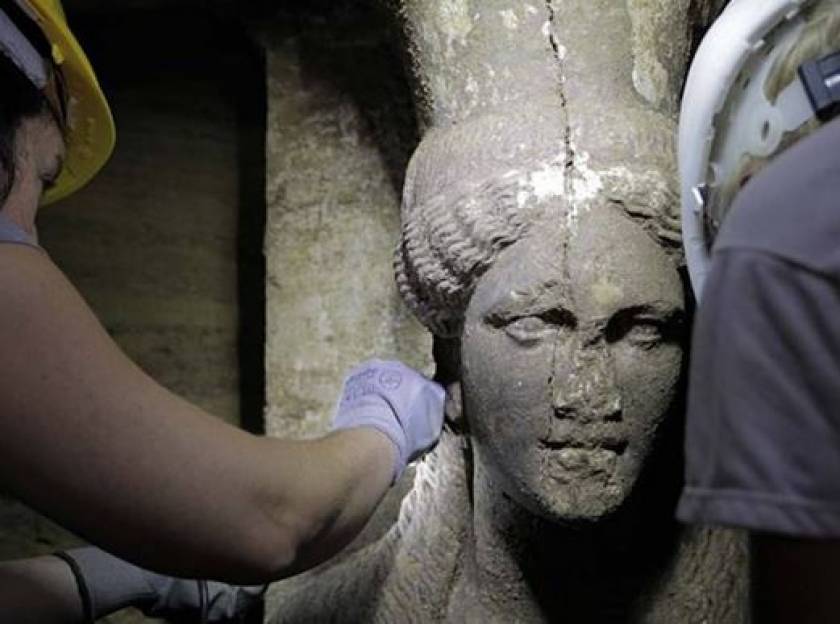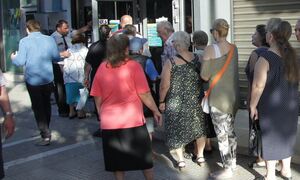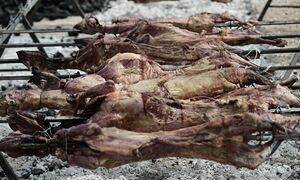Amphipolis: Looking for the identity of the buried person

The scenarios about the identity of the dead in the tomb on the Casta hill in Amphipolis are endless.
Archaeologists are day by day more and more close to give answer to the hitherto unsolved mystery about the identity of the person who is buried in the ancient tomb.
And while the "war" among archaeologists continues, the newspaper "Sunday Eleftherotypia" in an article, mentions 13 persons which are among the possible "occupant" of the tomb.
Alexander the Great
Amphipolis is the city from which he sailed for Asia. However is not mentioned in historiography that he is buried here, on the contrary, is certain that his tomb is located in Alexandria, since people like the Caesar have visited and have viewed the tomb.
Some 'writers' of history believe that Olympias transferred his bones here, in a cenotaph or even in a second tomb.
Olympias
The daughter of King Neoptolemus of Molossos, wife of Philip and Alexander's mother, returned from Epirus to Macedonia in 317 BC with an army and had taken under protection Roxanne and her grandson.
She killed the bastard son of Philip, Aridaios, when Cassandros besieged her in Pydna and forced her to capitulate. The siege of Cassandros lasted seven months.
The besieged were forced to eat an elephant, a gift of Alexander, and finally capitulated. Cassandros did not respect the terms of surrender and killed her by stoning in 316 BC. Her tomb is believed that is in Touba in Pydna and is unexcavated.
Cassandros kept Roxanne and Alexander close to him and murdered the young Alexander five years later in Amphipolis.
Cassandros
Cassandros, son of Antipater, did not follow the army of Alexander in Asia, but stayed with his father in Macedonia.
Collides with Polysperchon but eventually allied with him, when he kills the other son of Alexander, Heracles.
The half-brother of Alexander, Philip Aridaios and his wife Eurydice will find death by men of the Olympias, as the brother of Cassandros, Nicanor.
In 311 BC kills the successor of Alexander and Roxanne, who are imprisoned in his hands. He died of dropsy in 279 BC
Philip II
Those looking for the tomb of Philip in Amphipolis either do not accept that the tomb at Vergina is his or believe that there is a second monument.
The admirals of Alexander
Three admirals related to Amphipolis. Androsthenes, Laomedontas -who were born here- and Nearchus who was born here or exiled. Androsthenes from Thasos was geographer - cartographer and triirarchis of Alexander the Great.
Reached until Tylos, island in Bahrain today, and wrote the play "Circumnavigation of the Indian Sea". It is not known how and where he died and was buried. The Lion of Amphipolis deemed that was erected for Nearchos or Laomedon and Agnon, a century ago to honor the thousands of Athenians dead.
Another view wants the Lion to symbolize the glory of Amphipolis. Additional evidence on the basis of Leo is connected directly to the grave and the dead.
Polysperchon
General of Philip and Alexander, he returned to Greece from Asia in 324 BC -after the death of Alexander- and placed (by Antipatros) as commissioner of the state instead of his son Cassandros, who led him to his native Epirus, alongside Olympias and Roxanne.
When Olympias with the army invaded Macedonia, having murdered Philip III, Cassandros murdered her and took under his protection Roxanne and the son of Alexander.
Antigonus gave him another son of Alexander, Heracles, whom he murdered in 304 BC, abandoning the alliance with Antigonus and joined with the forces of Cassandros.
Hercules
Son of Alexander, he was murdered with his mother, the Persian, Barsine.
Alexander IV
The twelve years old son of Alexander and Roxanne was murdered with her. If his grave is located at Vergina, someone buried him there and "throw away" the corpse of his mother.
Glaucias, chief guard of Cassandros, was ordered to kill the little Alexander and Roxanne. The fact remained hidden.
Hephaestion
The view that the tomb belongs to Hephaestion is supported by Professor of History, Theodoros Mavrogiannis. The tomb was built in 325 BC by order of Alexander the Great.
Roxanne
The Persian wife of Alexander became the mother of his son in 323 BC after Alexander had died. Roxanne originally fled to Epirus to be saved from his descendants. Later, Roxanne fled to Amphipolis, where she and her son were murdered by Cassander in 310 BC.
Olympias, mother of Alexander, was murdered six years earlier. Alexander the Great had another wife, Parysatis, daughter of Artaxerxes III, and another son, Hercules, from Barsine. The fate of Parysatis is ignored.
Antigonus the One-eyed
Antigonus, a general of Alexander the Great, was proclaimed king in 306 BC. He was governor of Phrygia, when he became satrap. Collided with Perdiccas, allied with Antipater and refused to recognize the rule of Polyperchon who succeeded him.
After the death of Perdiccas -the 321 BC - he governed Asia Minor and Syria, until the adulthood of the son of Alexander. The peace of 311 BC ended when Cassandros murdered Roxane and her son. In 306 BC he proclaimed successor of Alexander after the occupation of Cyprus and demanded Macedonia from Cassandros.
The other three -Cassandros, Seleucus, Ptolemaios- defeated him at the Battle of Ipsos in 301 BC. He was already eighty-one years old and was buried with royal prices. In 294 BC his son Demetrius Poliorketes claimed Macedonia, which was controlled by the House of Antigonidon, as its conquest by the Romans in 168 BC
Philip the Arrhidaios
He was son of Philip who after the death of Alexander was proclaimed king by the Macedonian army as Philip III of Macedonia under the oversight of Perdiccas. He was killed by soldiers who defected to Olympias. His bones were transported by Cassandros in Aegae.
Polyandrion or Cenotaph
This view is supported by the various influences on the construction of the monument and its size. Mainly the idea presented because of the position of Amphipolis, as the apple of discord among the Athenians, Spartans and Macedonians, who when are not fighting each other, make alliance between them even temporarily.
Since the peace of Nicias in 421 BC to the time that the tomb dating, has passed over a century, but the site hosts objects from different eras.
The tomb of the Spartan Brasidas is located in the Agora of Amphipolis, where he was buried by the people of Amphipolis, the Spartans and their allies "as a national" hero.
The proponents of this view focus on the eyewitness testimony of Thucydides, who says that, in the city, was erected a monument and established annual games in his honor.
The fifty-year Peace of Nicias was not respected. Amphipolis was under the Macedonian occupation, which probably made other use of the monument. This means that parts of the "tomb" will confuse archaeologists either because it is not (as seen from its size) a grave, either because the findings will come from different seasons. In each case, the research must turn in museums and private collections.













